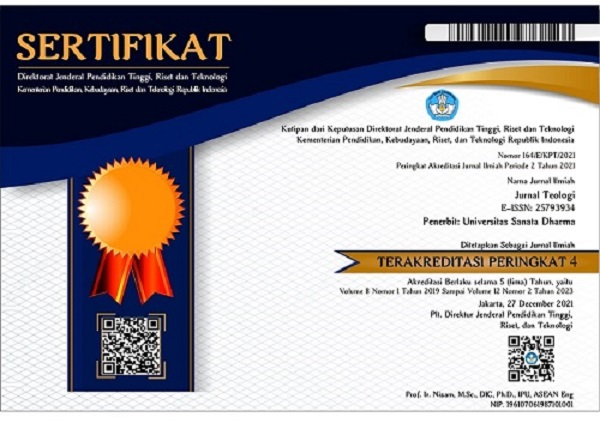Kristus Sebagai Pusat Perayaan Menurut Joseph Kardinal Ratzinger
(1) Pastor di Timika, Papua (Alumnus Program Magister Teologi Universitas Sanata Dharma)
(*) Corresponding Author
Abstract
Joseph Ratzinger stated that the great ideals of the Church are in crisis and the root cause is crisis in liturgy. How the Church shows her living faith is determined by how the church prays (lex orandi lex credendi). Using a method of literature review, the writer examines the writings of Joseph Ratzinger and his thought in the context of post Vatican II liturgy with its hermeneutical discourse, as reflected in Sacrosanctum Concilium.
Forgetting that liturgy is celebration of an encounter between God and human being, through the mediation of Christ, is problematic. The foundation of Christian liturgy is incarnation, where God reveals Himself as Logos, who opened Himself to human being. God starts the communication. Liturgical event occurs when the encounter is welcomed. Thus, liturgy celebrates an event of absolute encounter and communication between God and human being. Ratzinger insists that the center of the Church is Christ himself. The crisis of the Church happened because the Church has been losing its most fundamental identity which is Christ as its center. Reclaming its solid foundation which is Christ, the Church will return to her identity and ready to enrich its liturgical praxis with an active participation, vernacular, inculturated liturgical music as well as architecture.
Full Text:
PDFDOI: https://doi.org/10.24071/jt.v2i2.442
Refbacks
- There are currently no refbacks.

This work is licensed under a Creative Commons Attribution-ShareAlike 4.0 International License.
.jpg)
Indexed and abstracted in:
P-ISSN: 2302 - 5476 (Validity starting Volume 2012-10-05)
E-ISSN: 2579 - 3934 (Validity starting Volume 6, No. 1, Mei 2017)
Jurnal Teologi (Journal of Theology) by Faculty of Theology Sanata Dharma University

This work is licensed under a Creative Commons Attribution-ShareAlike 4.0 International License.














